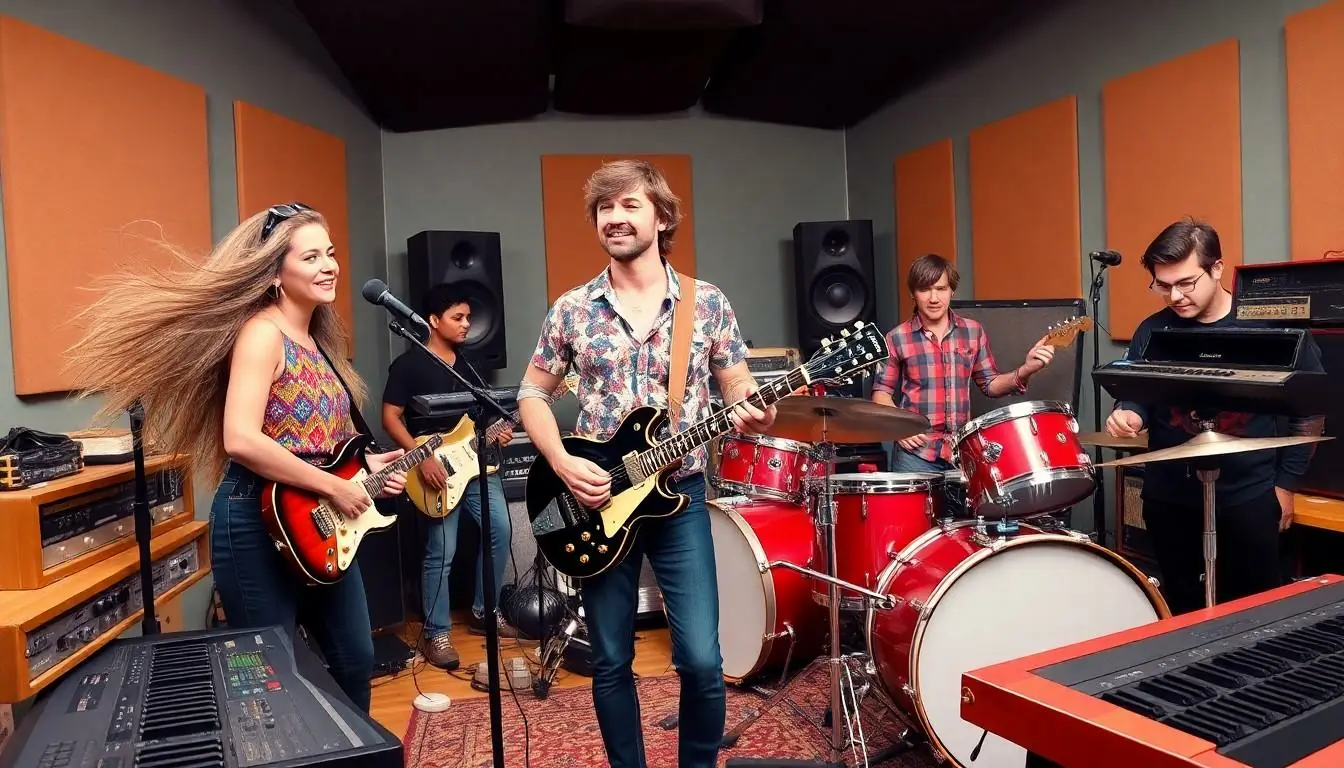Pop music isn’t just a catchy tune; it’s a cultural phenomenon that has shaped generations. From the infectious beats of the ’80s to today’s chart-topping hits, pop music has a rich history that’s as colorful as a neon dance floor. It’s the soundtrack to countless memories, from awkward school dances to epic road trips, and it’s time to dive into the fascinating background that makes it tick.
Ever wondered how your favorite pop stars went from obscurity to global icons? Or how a simple melody can spark a dance party in any living room? Understanding the roots of pop music reveals not just the artists but the societal shifts and trends that influenced their sound. So grab your headphones and get ready to explore the vibrant world of pop music, where every note tells a story and every beat invites you to dance.
Table of Contents
ToggleOverview Of Pop Music Background
Pop music traces its roots to the 1950s, emerging from a blend of various musical genres like rock and roll, jazz, and rhythm and blues. Artists shaped its sound by incorporating catchy hooks and relatable lyrics, catering to a broad audience. The genre quickly gained popularity, with the ’60s seeing the rise of iconic figures such as The Beatles and Elvis Presley, who contributed to its mainstream acceptance.
The ’80s marked a significant transformation with the introduction of synthesizers and electronic elements. This era produced legendary artists like Michael Jackson and Madonna, whose influences redefined pop music’s boundaries. New styles emerged, leading to the birth of sub-genres like dance-pop and synth-pop, appealing to diverse demographics.
By the ’90s, pop music began blending with elements from rap, hip-hop, and R&B, creating a fusion that resonated with younger audiences. Artists like Britney Spears and Backstreet Boys dominated the charts, showcasing the power of marketing and music videos in promoting pop culture.
In the 2000s and beyond, pop music adapted to digital changes, utilizing platforms like YouTube and streaming services to reach global audiences. Collaborations between pop and various genres, including country and EDM, became prevalent. Contemporary artists such as Taylor Swift and Billie Eilish demonstrate how pop continues to evolve while maintaining its core appeal.
Cultural influences, including social movements and technological advancements, play a crucial role in shaping pop music’s direction. The genre remains a reflection of societal trends and challenges, resonating with listeners on multiple levels. Through its evolution, pop music maintains its status as a powerful narrative vehicle, capturing the essence of different eras and experiences.
Historical Development

Pop music’s journey reflects a blend of culture and innovation. Each phase in its development introduces unique influences that shape its sound.
Early Influences
The 1950s marked the birth of pop music, heavily influenced by rock and roll, jazz, and rhythm and blues. Artists created memorable melodies with relatable lyrics, appealing to a vast audience. Figures like Buddy Holly and Chuck Berry played pivotal roles, embedding hooks into their songs that resonated with listeners. This era laid the groundwork, showcasing the importance of catchy tunes and the storytelling aspect of pop.
Evolution Through Decades
Pop music evolved significantly through the decades. The 1960s ushered in legendary artists like The Beatles and Elvis Presley, who brought pop into the mainstream. The introduction of synthesizers and electronic elements in the 1980s transformed its sound, with icons like Michael Jackson and Madonna leading the way. The 1990s witnessed blending with hip-hop and R&B, resulting in the rise of pop groups such as the Backstreet Boys and solo acts like Britney Spears. In the 2000s, digital platforms like YouTube reshaped how artists connected with fans, allowing for groundbreaking collaborations across genres.
Key Characteristics
Pop music boasts distinct features that shape its identity. Melodic structure and lyrical themes play pivotal roles in defining this genre.
Melodic Structure
Melodic structure often highlights simplicity and catchiness. Artists typically use repetitive hooks that invite sing-alongs. Melodies usually feature a range of notes that create memorable phrases. Chord progressions remain straightforward, enhancing accessibility for listeners. Instrumentation may vary; however, synthesizers and catchy rhythms frequently dominate. This characteristic appeals to a wide audience, fostering mainstream success.
Lyrical Themes
Lyrical themes in pop music frequently focus on universal experiences. Love, heartbreak, and self-empowerment are common subjects. Such topics resonate with listeners, creating emotional connections. Artists often incorporate storytelling elements, offering relatable narratives. Additionally, themes can address social issues and cultural phenomena. This versatility allows pop music to remain relevant across generations, reflecting societal changes. Overall, these lyrical elements contribute to pop music’s broad appeal and lasting impact.
Major Artists and Contributions
Pop music’s landscape includes numerous influential artists who shaped the genre’s trajectory.
Iconic Figures
The Beatles revolutionized pop music during the 1960s with innovative songwriting and harmonious melodies. Elvis Presley emerged as the “King of Rock and Roll,” bridging the gap between pop and rock genres through his charisma and vocal prowess. Michael Jackson, known as the “King of Pop,” introduced groundbreaking music videos that transformed the visual aspect of pop music. Madonna pushed boundaries with her provocative themes and reinvention of personal style, solidifying her status as a cultural icon. Each of these artists not only dominated the charts but also established templates for future pop stars.
Contemporary Influencers
Taylor Swift reshaped the pop landscape by blending country origins with mainstream appeal, proving adaptability is crucial. Billie Eilish defies conventional pop norms through her introspective lyrics and unique sound, appealing to a younger audience. Ed Sheeran’s knack for songwriting and collaborations has cemented his position in modern pop music. Drake’s fusion of rap and R&B elements helped redefine pop in the 2010s, bringing new audiences into the fold. These contemporary influencers continuously push the boundaries of pop, ensuring its evolution reflects current cultural dynamics.
Cultural Impact
Pop music holds immense cultural significance, influencing societal behaviors and shaping popular trends worldwide. Its accessibility allows for a shared experience among diverse demographics.
Globalization of Pop Music
Globalization has significantly transformed pop music, facilitating cross-cultural exchanges that create rich musical fusions. Artists from various countries incorporate local sounds into pop, resulting in unique blends that transcend geographical boundaries. K-pop’s meteoric rise exemplifies this phenomenon, drawing attention to Korean culture while appealing to a global audience. Latin pop, with stars like Shakira and J Balvin, illustrates how digital platforms enhance international reach. Social media further amplifies this trend, enabling artists to connect with fans worldwide instantly, thereby influencing music styles across different cultures.
Pop Music in Social Movements
Pop music often serves as a powerful tool for social movements, conveying messages that resonate with listeners. Artists use their platforms to address issues like inequality, mental health, and climate change. For instance, songs like “Alright” by Kendrick Lamar became anthems for the Black Lives Matter movement, motivating activism and awareness. Similarly, Madonna’s works challenged gender norms and sexuality, advocating for LGBTQ+ rights. During protests, pop songs unite individuals, creating a sense of community and urgency, demonstrating the genre’s capacity to inspire change and promote social justice.
Pop music remains a dynamic force that reflects society’s pulse. Its ability to adapt and evolve ensures it stays relevant across generations. The genre’s rich history is marked by innovation and cultural exchange, showcasing how artists continue to push boundaries while connecting with listeners on a personal level.
As pop music embraces new influences and technologies, it will undoubtedly shape the cultural landscape for years to come. The stories told through its melodies and lyrics resonate deeply, proving that pop music is more than just entertainment; it’s a powerful narrative that captures the essence of human experience.


